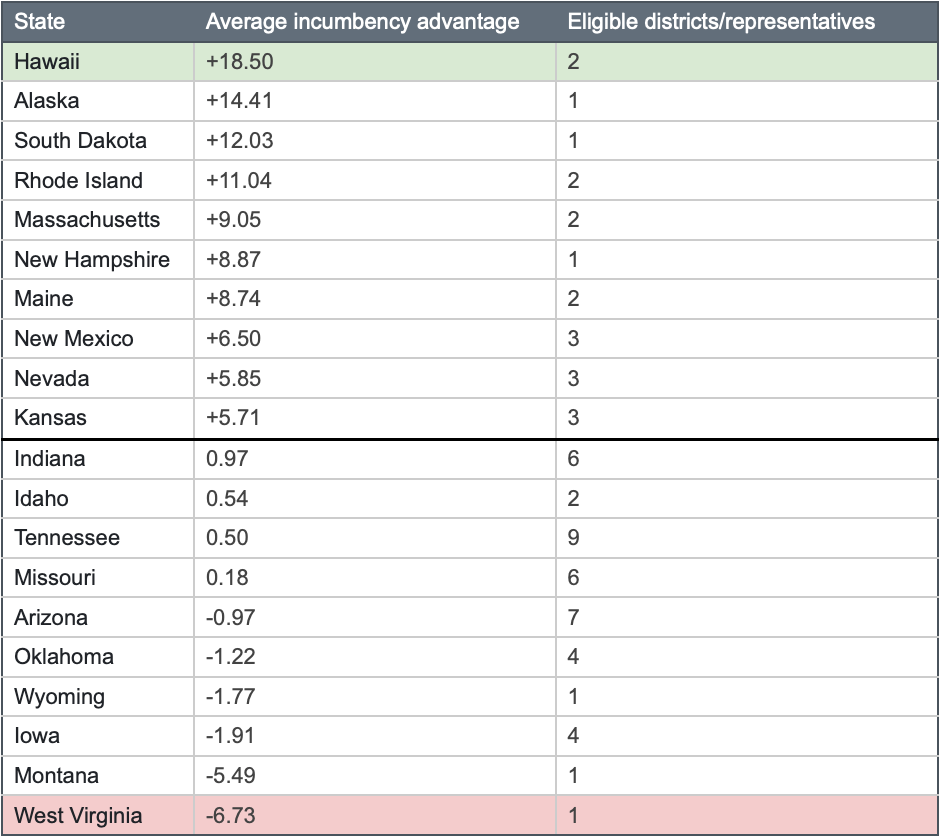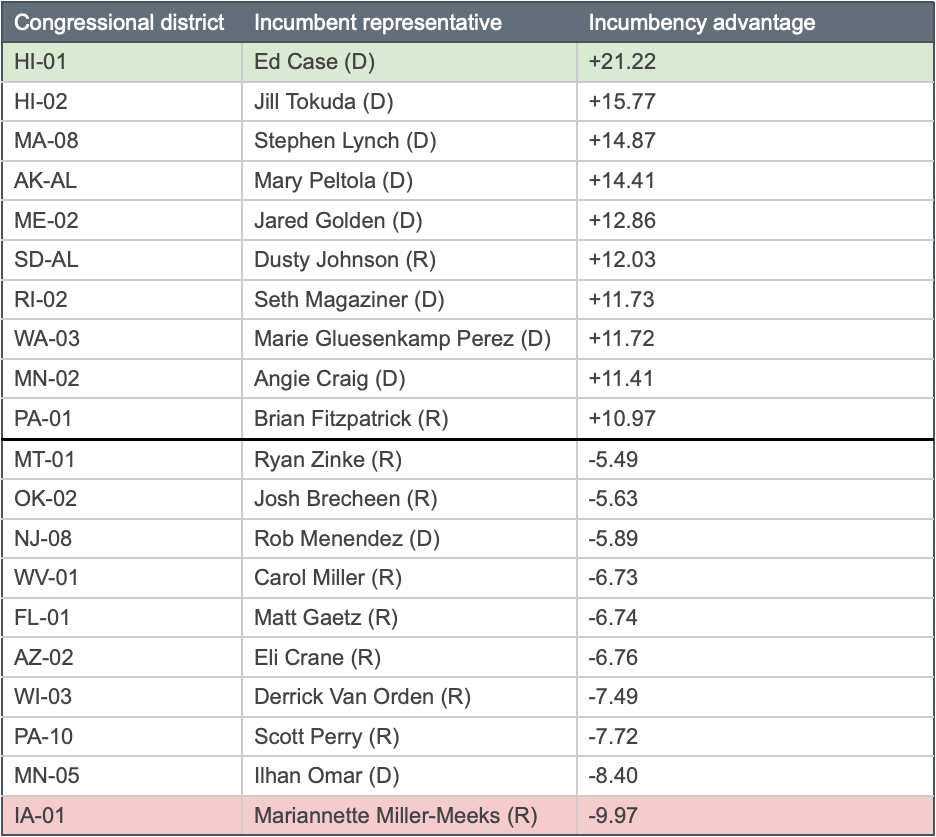Annotations Issue 32: In a Year of Change, Incumbents Held Ground in the U.S. House
Original research reveals that, despite 2024 trends suggesting a wave of incumbents losing re-election, the incumbent advantage remains a powerful force in U.S. elections.
Dear readers,
This week, Shamik Bhat (MPA ‘26) and Josh Varcie (MPA ‘26) share their original research on the state of the incumbency advantage after recent elections in the U.S. House of Representatives.
They find the average incumbent representative had a net incumbency advantage of 2.58 percentage points in the 2024 U.S. House elections, with the greatest effects in the Northeast. Bhat and Varcie present these results as a reminder of the importance of incumbency, with a warning that even this advantage does not protect a candidate from a district’s shifting ideals.
Send us your questions, ideas, pitches, comments, or thoughts! As policy students, right now is an important moment to speak out–Annotations exists as an outlet for you to do so. As a reminder, Annotations is JPIA’s running policy publication. We accept short pieces (500-1000 words) from Princeton students that provide reflection, policy analysis, or commentary on current affairs. Write to us at jpia@princeton.edu with your pitch or submission.
Happy reading!
Michelle, Paco, & Mera
JPIA Digital Editors
In a Year of Change, Incumbents Held Ground in the U.S. House
By Shamik Bhat '26 and Josh Varcie '26
As the dust settled on the 2024 U.S. presidential election and elections across the globe, a pervasive narrative emerged: voters expressed their political and economic discontent by punishing those already holding office. Globally, we saw a series of electoral defeats for incumbent political parties and executives, including the resurgence of the United Kingdom’s Labour Party, significant losses for Modi’s Bharatiya Janata Party in India, and, of course, Donald Trump’s defeat of Kamala Harris in the U.S. presidential elections.
The results of the 2024 U.S. House of Representative elections, however, suggested a different story. Overall, the Republican Party lost only one of the 221 seats they held, and only 15 of 381 incumbent legislators who ran for re-election across both parties were not re-elected. While there are many factors influencing these election results, we wanted to explore the role of the incumbency advantage. To do so, we collected election returns for each congressional district to calculate the average incumbency advantage across all districts in 2024. We found that U.S. representatives already holding office enjoyed a small incumbency advantage with a similar magnitude to that observed in 2018. We also find the incumbency advantage was larger for legislators in the U.S. Northeast, with a smaller advantage across other regions.
What is the incumbency advantage?
Scholars have documented an incumbency advantage in U.S. congressional elections since the 1960s. Formally, it is defined as the increased electoral support a candidate receives in an election because they currently occupy the office.
U.S. congressional incumbents enjoy resource advantages, like higher campaign revenues from fundraisers, party support, and the ability to send mail for free (Fouirnaies and Hall 2014; Mayhew 1974). Incumbents may also enjoy what scholars describe as a “homestyle” advantage, whereby constituents reward incumbents who have benefited–or are perceived to have benefited–the district. This may be because incumbents assisted voters with casework, or simply because incumbents have higher name recognition than their opposition (Fenno 1978; Kam and Zechmeister 2013). Finally, incumbents may enjoy certain electoral process advantages. For example, incumbents' resource advantages may dissuade high-quality challengers from running for office (Cox and Katz 1996). During redistricting, incumbents may also strategically draw district boundaries to favor their chances of re-election (Ansolabehere et al. 2000).
The incumbency advantage has important ramifications for policy. On the one hand, a large incumbency advantage helps incumbents get re-elected at a higher rate. To the extent that having an experienced legislature leads to better policy outcomes, the incumbency advantage may be a boon to policymaking. On the other hand, a large incumbency advantage also decreases electoral competitiveness. A lack of electoral competitiveness can weaken legislators’ responsiveness to voters, reduce the odds that young and diverse candidates win elected office, and contribute to electoral polarization.
The incumbency advantage in 2024 U.S. House elections
To explore the incumbency advantage in 2024 U.S. House elections, we calculate the incumbency advantage for 206 congressional districts that had not been redistricted since 2022 and were contested by both major political parties. Our calculation takes into account an incumbent’s performance relative to the district’s underlying partisanship and how responsive the district is to national swings in the electorate. These calculations are described in detail in the appendix.
Our analysis reveals that the average incumbent representative had a net incumbency advantage of 2.58 percentage points in the 2024 U.S. House elections. This incumbency advantage is similar in magnitude to the reported incumbency advantage of 2.7 percentage points in the 2018 midterm elections (Rakich 2018).
Our analysis also shows that the incumbency advantage differed by region, with the Northeast seeing the strongest effect. Incumbents in the Northeast outperformed by 3.70 percentage points, incumbents in the West outperformed by 2.45 percentage points, incumbents in the Midwest outperformed by 2.23 percentage points, and incumbents in the South outperformed by 2.71 percentage points. Table 1 shows the average incumbency advantage by region, and the number of congressional districts analyzed.
Table 1. Average incumbency advantage in 2024 by U.S. Census Regions
Looking at specific states, Hawaii (+18.50) and Alaska (+14.41) had the largest average incumbency advantages, while West Virginia (-6.73) and Montana (-5.49) had the highest incumbent disadvantages. These states all have one or few districts, making them more prone to outliers in individual incumbent performances. Of the 43 states with eligible districts, 37 (86.0%) had incumbency advantages on average, while 6 (14.0%) had incumbency disadvantages on average. Table 2 below shows the average incumbency advantage for states with the highest and lowest average incumbency advantage.
Table 2. States with top 10 average and bottom 10 incumbency advantage in 2024
There are some caveats when considering these results: seven states were not included in this analysis, either due to their districts having no incumbents (e.g., DE, ND) or districts being redrawn after 2022 (e.g., LA, NY, NC). Some populous states that are included have few eligible districts analyzed (e.g., MA) due to many districts going uncontested by one party.
Looking at individual representatives, variance is more broad: Ed Case (D) in HI-01 had the strongest factor, at +21.22 percentage points, while Mariannette Miller-Meeks (R) in IA-01 had the weakest factor, at -9.97 percentage points. Below in Table 3 are the 10 strongest and weakest incumbents:
Table 3. Strongest and weakest 10 incumbent representatives in 2024
It is challenging to separate incumbent performances from a potentially unpopular challenger, lending the appearance of strength for the incumbent. There are also other factors–such as national party attention to certain races–that are important to consider. However, there are still significant lessons to be drawn from these findings. Representative Peltola, Gluesenkamp Perez, and Golden significantly overperformed in traditionally Republican districts, with Perez and Golden winning their elections due to their overperformances. All three are considered moderate within the Democratic Party, and this moderate brand may have helped win crossover votes in their districts. On the contrary, Representative Ilhan Omar, who is a member of “The Squad” (a leftwing faction of House Democrats) may have faced an electoral penalty because of her ideological stances.
Controversy—or even the appearance of one—can also lead to an incumbency disadvantage. Matt Gaetz in FL-01 is perhaps the most significant example; it should be no surprise that investigations into his alleged sex scandals resulted in nearly a 7 percentage point disadvantage. Representative Menendez, who won despite his underperformance, also exhibits this effect: he is the son of former Senator Bob Menendez, who resigned from the Senate in August 2024 after being convicted of federal bribery charges.
Conclusion
In this article, we examined the strength of the advantage conferred by incumbency in the House of Representatives in 2024. We found an average incumbency advantage of 2.58 percentage points across all districts, with the strongest effect in the Northeast. Representatives Ed Case (D, HI-01) and Jill Tokuda (D, HI-02) were the strongest incumbents in 2024, while Mariannette Miller-Meeks (R, IA-01) and Ilhan Omar (D, MN-05) were the weakest.
These findings serve as a reminder of the strength of incumbency; we find that most incumbent candidates enjoy a non-trivial electoral advantage. As a result, the privilege of incumbency may permit legislators to deviate from their districts’ preferences when making policy decisions. However, our findings also serve as a warning—ideologically extreme representatives and those embroiled in controversy (or the appearance of controversy) may be punished for straying too far from their district’s preferences. Going forward, those advising policymakers in Congress should recognize that while the incumbency remains a major force in U.S. House elections, its advantage is anything but certain.
Please find the References and Appendix for this piece on the Annotations website.
Meet the Author: Shamik Bhat
Shamik's experiences with healthcare across the United States led him to explore both medicine and health policy. At the University of Colorado, Denver, he studied biology and political science while working with Children's Hospital Colorado to build hands-on, unique educational experiences for patients. Having finished his third year of medical school at Yale, he is now exploring the economic and political determinants of health at Princeton SPIA, ranging from housing policy to pharmaceutical price transparency. He ultimately hopes to use these experiences and lessons to better advocate for patients both in the hospital and on Capitol Hill.
Meet the Author: Josh Varcie
Josh was born and raised in Commerce Township, Michigan, a suburb of Detroit. Before attending Princeton, he worked as an Assistant Analyst in the Health Analysis Division of the Congressional Budget Office (CBO), where he contributed to analyses on prescription drugs, the Affordable Care Act (ACA), and long-term care. Prior to the CBO, Josh traveled the country campaigning for Joe Biden across five states during the 2020 presidential election. Josh hopes to serve in a role where he can use data and programming tools to solve pressing healthcare policy challenges, particularly at the federal level.








